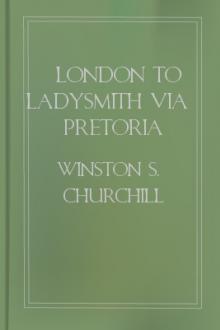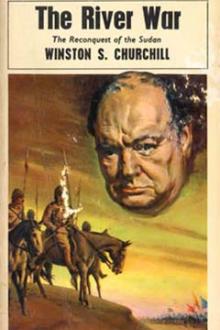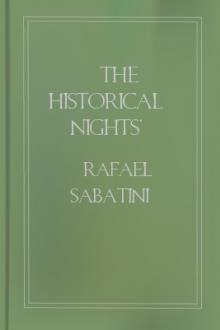London to Ladysmith via Pretoria, Winston Churchill [digital ebook reader txt] 📗

- Author: Winston Churchill
- Performer: -
Book online «London to Ladysmith via Pretoria, Winston Churchill [digital ebook reader txt] 📗». Author Winston Churchill
We reached the ridge and cover in a minute, and it was very pretty to see these irregular soldiers stop their horses and dismount with their carbines at once without any hesitation. Along the ridge Captain Hill's Colt Battery was drawn up in line, and as soon as the front was clear the four little pink guns began spluttering furiously. The whole of the South African Light Horse dismounted and, lining the ridge, opened fire with their rifles. Thorneycroft's Mounted Infantry came into line on our left flank, and brought two tripod Maxims into action with them. Lord Dundonald sent back word to the battery to halt and fire over our heads, and Major Gough's Regiment and the Royal Welsh Fusiliers, who had almost reached cover, turned round of their own accord and hurried eagerly in the direction of the firing, which had become very loud on both sides.
There now ensued a strange little skirmish, which would have been a bloody rifle duel but for the great distance which separated the combatants and for the cleverness with which friends and foes concealed and sheltered themselves. Not less than four hundred men on either side were firing as fast as modern rifles will allow. Between us stretched the smooth green dip of ground. Beyond there rose the sharper outlines of Hussar Hill, two or three sheds, and a few trees. That was where the Boers were. But they were quite invisible to the naked eye, and no smoke betrayed their positions. With a telescope they could be seen—a long row of heads above the grass. We were equally hidden. Still their bullets—a proportion of their bullets—found us, and I earnestly trust that some of ours found them. Indeed there was a very hot fire, in spite of the range. Yet no one was hit. Ah, yes, there was one, a tall trooper turned sharply on his side, and two of his comrades carried him quickly back behind a little house, shot through the thigh. A little further along the firing line another was being helped to the rear. The Colt Battery drew the cream of the fire, and Mr. Garrett, one of the experts sent out by the firm, was shot through the ankle, but he continued to work his gun. Captain Hill walked up and down his battery exposing himself with great delight, and showing that he was a very worthy representative of an Irish constituency.
I happened to pass along the line on some duty or other when I noticed my younger brother, whose keen desire to take some part in the public quarrel had led me, in spite of misgivings, to procure him a lieutenancy, lying on the ground, with his troop. As I approached I saw him start in the quick, peculiar manner of a stricken man. I asked him at once whether he was hurt, and he said something—he thought it must be a bullet—had hit him on the gaiter and numbed his leg. He was quite sure it had not gone in, but when we had carried him away we found—as I expected—that he was shot through the leg. The wound was not serious, but the doctors declared he would be a month in hospital. It was his baptism of fire, and I have since wondered at the strange caprice which strikes down one man in his first skirmish and protects another time after time. But I suppose all pitchers will get broken in the end. Outwardly I sympathised with my brother in his misfortune, which he mourned bitterly, since it prevented him taking part in the impending battle, but secretly I confess myself well content that this young gentleman should be honourably out of harm's way for a month.
It was neither our business nor our pleasure to remain and continue this long-range duel with the Boers. Our work for the day was over, and all were anxious to get home to luncheon. Accordingly, as soon as the battery had come into action to cover our withdrawal we commenced withdrawing squadron by squadron and finally broke off the engagement, for the Boers were not inclined to follow further. At about three o'clock our loss in this interesting affair was one officer, Lieutenant John Churchill, and seven men of the South African Light Horse wounded and a few horses. Thorneycroft's Mounted Infantry also had two casualties, and there were two more in the Colt detachments. The Boers were throughout invisible, but two days later when the ground was revisited we found one dead burgher—so that at any rate they lost more heavily than we. The Colt guns worked very well, and the effect of the fire of a whole battery of these weapons was a marked diminution in the enemy's musketry. They were mounted on the light carriages patented by Lord Dundonald, and the advantage of these in enabling the guns to be run back by hand, so as to avoid exposing the horses, was very obvious.
I shall leave the great operation which, as I write, has already begun, to another letter, but since gaiety has its value in these troublous times let the reader pay attention to the story of General Hart and the third-class shot. Major-General Hart, who commands the Irish Brigade, is a man of intrepid personal courage—indeed, to his complete contempt for danger the heavy losses among his battalions, and particularly in the Dublin Fusiliers, must be to some extent attributed. After Colenso there were bitter things said on this account. But the reckless courage of the General was so remarkable in subsequent actions that, being brave men themselves, they forgave him everything for the sake of his daring. During the first day at Spion Kop General Hart discovered a soldier sitting safely behind a rock and a long way behind the firing line.
'Good afternoon, my man,' he said in his most nervous, apologetic voice; 'what are you doing here?'
'Sir,' replied the soldier, 'an officer told me to stop here, sir.'
'Oh! Why?'
'I'm a third-class shot, sir.'
'Dear me,' said the General after some reflection, 'that's an awful pity, because you see you'll have to get quite close to the Boers to do any good. Come along with me and I'll find you a nice place,' and a mournful procession trailed off towards the most advanced skirmishers.[3]
FOOTNOTES:
[3]
The map at the end of Chapter XXV. illustrates this and succeeding chapters.
CHAPTER XXIITHE ENGAGEMENT OF MONTE CRISTO
Cingolo Neck: February 19, 1900.
Not since I wrote the tale of my escape from Pretoria have I taken up my pen with such feelings of satisfaction and contentment as I do to-night. The period of doubt and hesitation is over. We have grasped the nettle firmly, and as shrewdly as firmly, and have taken no hurt. It remains only to pluck it. For heaven's sake no over-confidence or premature elation; but there is really good hope that Sir Redvers Buller has solved the Riddle of the Tugela—at last. At last! I expect there will be some who will inquire—'Why not "at first"?' All I can answer is this: There is certainly no more capable soldier of high rank in all the army in Natal than Sir Redvers Buller. For three months he has been trying his best to pierce the Boer lines and the barrier of mountain and river which separates Ladysmith from food and friends; trying with an army—magnificent in everything but numbers, and not inconsiderable even in that respect—trying at a heavy price of blood in Africa, of anxiety at home. Now, for the first time, it seems that he may succeed. Knowing the General and the difficulties, I am inclined to ask, not whether he might have succeeded sooner, but rather whether anyone else would have succeeded at all. But to the chronicle!
Anyone who stands on Gun Hill near Chieveley can see the whole of the Boer position about Colenso sweeping before him in a wide curve. The mountain wall looks perfectly unbroken. The river lies everywhere buried in its gorge, and is quite invisible. To the observer there is only a smooth green bay of land sloping gently downward, and embraced by the rocky, scrub-covered hills. Along this crescent of high ground runs—or rather, by God's grace, ran the Boer line, strong in its natural features, and entrenched from end to end. When the map is consulted, however, it is seen that the Tugela does not flow uniformly along the foot of the hills as might be expected, but that after passing Colenso village, which is about the centre of the position, it plunges into the mountainous country, and bends sharply northward; so that, though the left of the Boer line might appear as strong as the right, there was this difference, that the Boer right had the river on its front, the Boer left had it in its rear.
The attack of the 15th of December had been directed against the Boer right, because after reconnaissance Sir Redvers Buller deemed that, in spite of the river advantage, the right was actually the weaker of the two flanks. The attack of the 15th was repulsed with heavy loss. It might, therefore, seem that little promise of success attended an attack on the Boer left. The situation, however, was entirely altered by the great reinforcements in heavy artillery which had reached the army, and a position which formerly appeared unassailable now looked less formidable.
Let us now consider the Boer left by itself. It ran in a chain of sangars, trenches, and rifle pits, from Colenso village, through the scrub by the river, over the rugged hill of Hlangwani, along a smooth grass ridge we called 'The Green Hill,' and was extended to guard against a turning movement on to the lofty wooded ridges of Monte Cristo and Cingolo and the neck joining these two features. Sir Redvers Buller's determination was to turn this widely extended position on its extreme left, and to endeavour to crumple it from left to right. As it were, a gigantic right arm was to reach out to the eastward, its shoulder at Gun Hill, its elbow on Hussar Hill, its hand on Cingolo, its fingers, the Irregular Cavalry Brigade, actually behind Cingolo.
On February 12th a reconnaissance in force of Hussar Hill was made by Lord Dundonald. On the 14th the army moved east from Chieveley to occupy this ground. General Hart with one brigade held Gun Hill and Railhead. The First Cavalry Brigade watched the left flank at Springfield, but with these exceptions the whole force marched for Hussar Hill. The Irregular Cavalry covered the front, and the South African Light Horse, thrown out far in advance, secured the position by half-past eight, just in time to forestall a force of Boers which had been despatched, so soon as the general movement of the British was evident, to resist the capture of the hill. A short sharp skirmish followed, in which we lost a few horses and men, and claim to have killed six Boers, and which was terminated after half an hour by the arrival of the leading Infantry battalion—the Royal Welsh Fusiliers. During the day the occupation was completed, and the brigades of Generals Wynne, Coke, and Barton, then joining Warren's Division with





Comments (0)